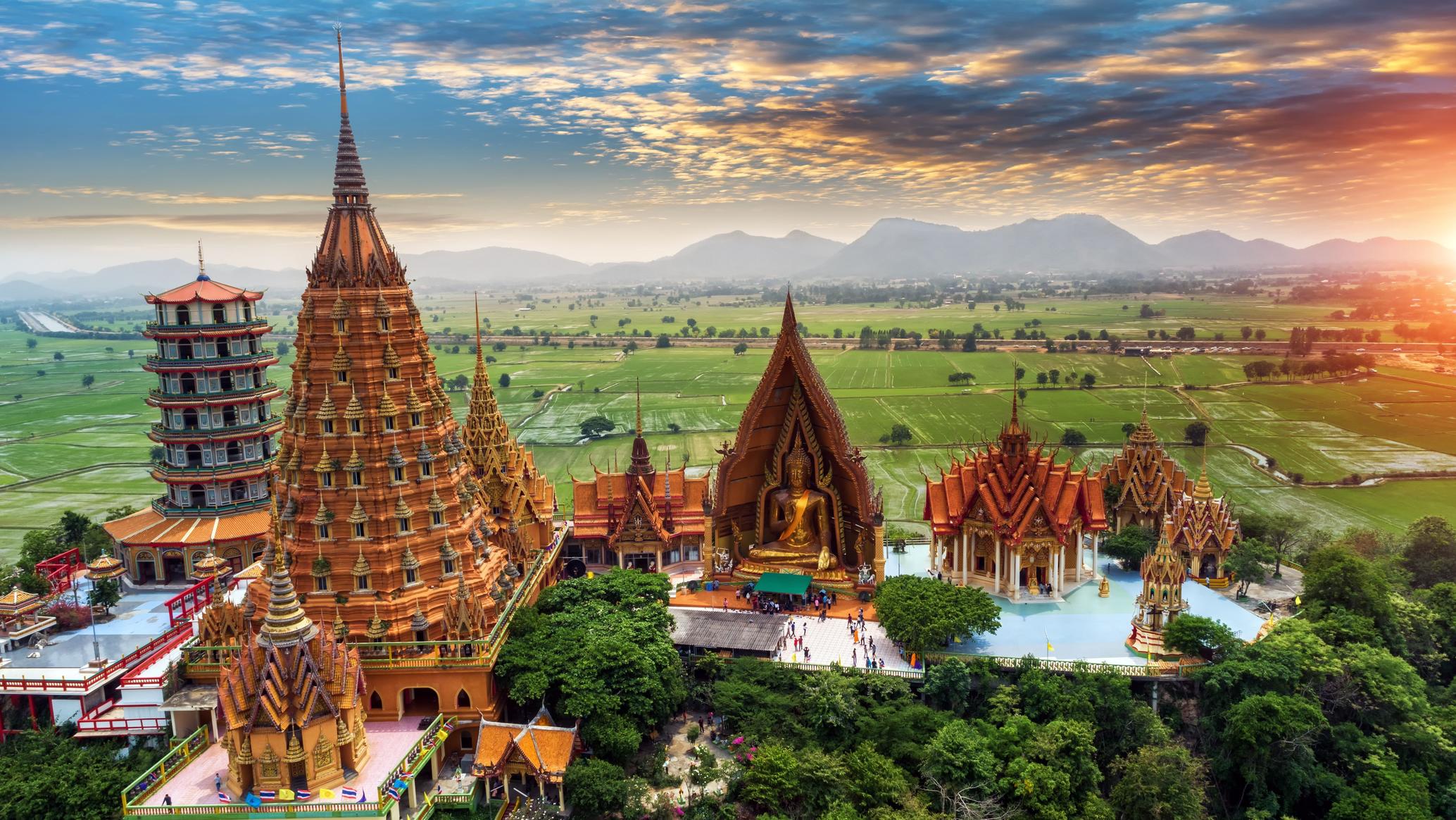
Kanchanaburi is a fascinating province located in western Thailand. Known for its breathtaking natural beauty and rich historical significance, Kanchanaburi has become a popular tourist destination for both nature lovers and history enthusiasts. The province is home to several stunning national parks, charming riverside towns, and iconic landmarks that attract visitors from around the world.
From the famous Bridge over the River Kwai to the intriguing Erawan Waterfall, Kanchanaburi offers a diverse range of attractions and activities. Whether you’re interested in exploring ancient temples, immersing yourself in the local culture, or embarking on thrilling outdoor adventures, Kanchanaburi has something for everyone.
In this article, we will uncover 32 fascinating facts about Kanchanaburi that will deepen your understanding and appreciation for this remarkable destination. So, grab your map and get ready to explore the wonders of Kanchanaburi!
Key Takeaways:
- Kanchanaburi, Thailand, is a historical and scenic province famous for the Death Railway, Bridge over the River Kwai, Erawan National Park, and vibrant cultural events like the River Kwai Bridge Week.
- Visitors to Kanchanaburi can enjoy outdoor adventures, explore caves and waterfalls, experience local traditions at night markets, and pay respects at war cemeteries, making it a diverse and enriching destination.
Kanchanaburi is a province in western Thailand.
Kanchanaburi, located about 129 kilometers west of Bangkok, is a scenic province famous for its historical significance and natural beauty.
The Death Railway passes through Kanchanaburi.
The Death Railway, built during World War II by prisoners of war, runs across the picturesque landscape of Kanchanaburi and is a major tourist attraction.
Kanchanaburi is home to the famous Bridge over the River Kwai.
The Bridge over the River Kwai, immortalized in literature and film, is a must-visit landmark in Kanchanaburi. It is a poignant reminder of the dark history associated with the Death Railway.
Erawan National Park is located in Kanchanaburi.
Erawan National Park is known for its stunning seven-tiered waterfall, which is a popular spot for hiking and swimming in the crystal-clear turquoise pools.
The famous Tiger Temple used to be in Kanchanaburi.
The Tiger Temple, also known as Wat Pha Luang Ta Bua, was a controversial attraction where visitors could interact with tigers. However, it was closed down in 2016 due to concerns about animal welfare.
The Hellfire Pass Museum is a somber reminder of the Death Railway’s history.
The Hellfire Pass Museum and Memorial is dedicated to preserving the memories of the POWs who worked on the Death Railway. It provides visitors with a moving and educational experience.
Kanchanaburi is renowned for its floating markets.
The floating markets of Kanchanaburi, such as the iconic Damnoen Saduak Floating Market, offer a unique shopping experience where vendors sell their goods from traditional long-tail boats.
Kanchanaburi is a gateway to exploring Sai Yok National Park.
Sai Yok National Park is known for its lush jungles, waterfalls, and the famous Sai Yok Noi Waterfall, making Kanchanaburi an ideal base for nature enthusiasts.
The annual River Kwai Bridge Week is a highlight for visitors.
During the River Kwai Bridge Week, various events and ceremonies take place to commemorate the history of the Death Railway. It attracts both locals and tourists.
Kanchanaburi offers a variety of outdoor activities.
From bamboo rafting on the River Kwai to elephant trekking in the jungle, Kanchanaburi provides a wide range of outdoor adventures for thrill-seekers.
The JEATH War Museum provides insight into the lives of POWs.
The JEATH War Museum, located near the Bridge over the River Kwai, exhibits photographs and artifacts from the time of the Death Railway, offering a glimpse into the harsh conditions endured by the prisoners.
The famous Sai Yok Yai Waterfall is situated in Kanchanaburi.
The Sai Yok Yai Waterfall, surrounded by lush tropical forests, is a stunning natural wonder that attracts visitors with its cascading beauty.
The annual Kanchanaburi Red Cross Fair is a lively celebration.
The Kanchanaburi Red Cross Fair is a vibrant event held each year in January. It features cultural performances, delicious food stalls, and entertaining games.
The Chong Kai War Cemetery is a solemn memorial to Allied soldiers.
The Chong Kai War Cemetery honors the Allied prisoners who lost their lives during the construction of the Death Railway, serving as a reminder of the sacrifices made.
Kanchanaburi is known for its delicious street food.
The streets of Kanchanaburi are lined with food stalls offering a variety of mouthwatering Thai dishes, including pad Thai, mango sticky rice, and grilled satay skewers.
The Lawa Cave is a popular attraction in Kanchanaburi.
The Lawa Cave, also known as the Dragon Head Cave, is a limestone cave complex known for its impressive stalactite and stalagmite formations.
Kanchanaburi is home to the beautiful Three Pagodas Pass.
The Three Pagodas Pass, located on the border between Thailand and Myanmar, is a historic site where three unique pagodas stand as a symbol of cultural diversity.
Kanchanaburi offers opportunities for river cruises.
Exploring the River Kwai by boat is a popular activity in Kanchanaburi, allowing visitors to take in the scenic beauty of the surroundings at a leisurely pace.
Wat Tham Khao Pun is a Buddhist temple with a cave complex.
Wat Tham Khao Pun, located on a hillside, features a cave complex adorned with colorful Buddhist statues and offers a peaceful and spiritual experience.
The annual Kanchanaburi Heritage Marathon attracts runners from around the world.
Running enthusiasts gather in Kanchanaburi every year to participate in the Kanchanaburi Heritage Marathon, which takes them through the province’s scenic landscapes.
Kanchanaburi is known for its vibrant night markets.
The night markets of Kanchanaburi come alive in the evenings with stalls selling clothing, handicrafts, souvenirs, and a wide array of delectable street food.
The Phra Pathommachedi is the tallest stupa in Thailand.
The Phra Pathommachedi, located in Nakhon Pathom near Kanchanaburi, is an impressive stupa standing at a height of 127 meters, making it a significant religious site.
Kanchanaburi is a paradise for birdwatchers.
With its diverse ecosystems, Kanchanaburi is home to a wide variety of bird species, making it a perfect destination for avid birdwatchers.
The annual River Kwai Bridge Festival showcases local traditions.
The River Kwai Bridge Festival, held in November, features cultural performances, light and sound shows, and a market selling traditional handicrafts.
Kanchanaburi offers opportunities for elephant encounters.
Visitors can have close encounters with elephants at ethically-operated elephant sanctuaries in Kanchanaburi, where conservation and the well-being of these majestic creatures are a priority.
The Wat Ban Tham is a striking temple built into a limestone cave.
Wat Ban Tham, nestled within a cave, features intricately carved Buddha statues and offers panoramic views of the surrounding countryside.
The Kanchanaburi War Cemetery pays tribute to fallen soldiers.
The Kanchanaburi War Cemetery, maintained by the Commonwealth War Graves Commission, is a poignant memorial where the remains of Allied soldiers who died during the construction of the Death Railway are laid to rest.
Kanchanaburi is home to the endangered Asian elephant.
The jungles and sanctuaries of Kanchanaburi provide a sanctuary for the Asian elephant, playing a vital role in their conservation efforts.
The annual River Kwai Jazz Festival attracts music lovers.
Music enthusiasts gather in Kanchanaburi to enjoy the enchanting melodies of jazz at the River Kwai Jazz Festival, held every February.
The Prasat Muang Singh Historical Park showcases ancient Khmer ruins.
Prasat Muang Singh, a historical park in Kanchanaburi, features Khmer ruins dating back to the 12th century and provides insights into the region’s rich cultural heritage.
Kanchanaburi is renowned for its scenic train rides.
The train journey from Kanchanaburi to Nam Tok offers breathtaking views of the countryside and passes through the famous Bridge over the River Kwai.
Kanchanaburi is a peaceful and serene destination.
With its natural beauty, historical significance, and tranquil atmosphere, Kanchanaburi provides a perfect escape from the hustle and bustle of city life.
Conclusion
In conclusion, Kanchanaburi is a fascinating destination with a rich history and stunning natural beauty. From the famous Bridge over the River Kwai to the Erawan National Park, this city offers a diverse range of attractions for visitors to explore. Whether you’re interested in history, outdoor adventures, or simply enjoying the laid-back atmosphere, Kanchanaburi has something to offer everyone.With its unique cultural heritage, vibrant markets, and delicious local cuisine, Kanchanaburi provides a truly immersive experience for travelers. From exploring historical sites like the War Cemetery and Hellfire Pass to enjoying a scenic boat ride along the River Kwai, there are endless opportunities to learn, relax, and create lasting memories in this captivating city.So, if you’re planning your next getaway, consider adding Kanchanaburi to your travel itinerary. Immerse yourself in its incredible history, indulge in its natural beauty, and discover the true essence of this remarkable destination. Kanchanaburi is sure to leave a lasting impression on your heart and mind.
FAQs
1. What is the best time to visit Kanchanaburi?
Answer: The best time to visit Kanchanaburi is during the cool season, from November to February, when the weather is pleasant and temperatures are more comfortable for outdoor activities.
2. How can I get to Kanchanaburi from Bangkok?
Answer: Kanchanaburi is located around 130 kilometers west of Bangkok. You can reach Kanchanaburi by bus, train, or private car. Buses and trains are the most common modes of transportation, and the journey takes around 2-3 hours.
3. Are there any accommodations available in Kanchanaburi?
Answer: Yes, Kanchanaburi offers a wide range of accommodations to suit every budget and preference. From luxury resorts and boutique hotels to guesthouses and homestays, you’ll find plenty of options to choose from.
4. What are the must-visit attractions in Kanchanaburi?
Answer: Some of the must-visit attractions in Kanchanaburi include the Bridge over the River Kwai, Erawan National Park, Hellfire Pass Memorial, Death Railway Museum, and Sai Yok Noi Waterfall.
5. Is it safe to travel to Kanchanaburi?
Answer: Kanchanaburi is generally a safe destination for travelers. However, it’s always advisable to take necessary precautions, such as securing your belongings and being aware of your surroundings, to ensure a hassle-free trip.
Kanchanaburi's allure extends beyond its historical sites and natural wonders. Immerse yourself in the vibrant atmosphere of the Kanchanaburi Water Festival, where joy and tradition intertwine. Sports enthusiasts can explore the fascinating Kanchanaburi Province Stadium, a hub of athletic prowess. For nature lovers, Erawan Falls beckons with its breathtaking beauty and serene surroundings. Each experience in Kanchanaburi promises a unique and unforgettable adventure, leaving you eager to uncover more of its hidden treasures.
Was this page helpful?
Our commitment to delivering trustworthy and engaging content is at the heart of what we do. Each fact on our site is contributed by real users like you, bringing a wealth of diverse insights and information. To ensure the highest standards of accuracy and reliability, our dedicated editors meticulously review each submission. This process guarantees that the facts we share are not only fascinating but also credible. Trust in our commitment to quality and authenticity as you explore and learn with us.


